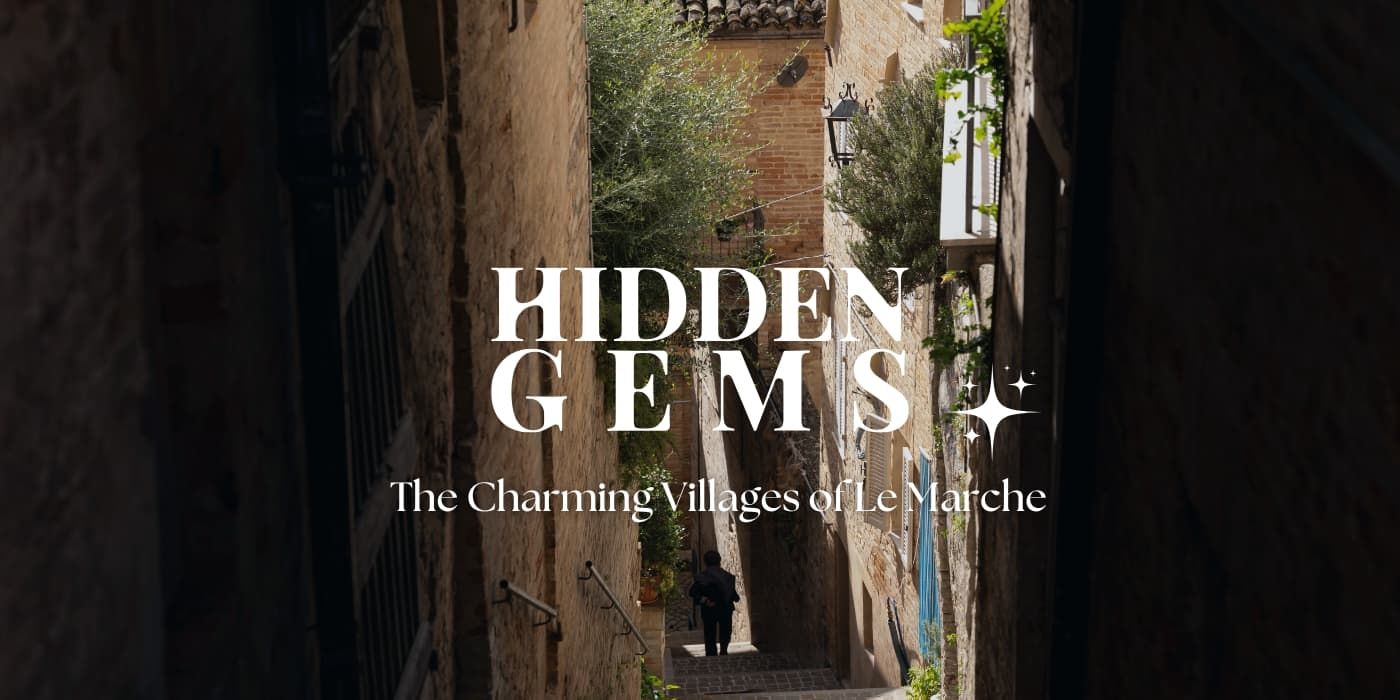Sometimes getting lost is the only way to truly find yourself. Traveling through the heart of Le Marche, among silent hills fragrant with flowers, I took a secondary road. This is how my true journey began: an unexpected adventure through eleven hidden villages of Le Marche, where history and beauty intertwine at every corner.
In each episode, I will take you to a unique village, revealing the secrets of its ancient streets, amidst breathtaking landscapes and timeless stories.
Come with me: this is Hidden Gems - The Charming Villages of Le Marche.
Today we' will get to Falerone.

Listen to "Hidden Gems - The Charming Villages of Le Marche: Falerone"
Chapter one: A day in Falerone, the itinerary I’ve chosen

Nestled among the stunning scenery of the Fermano hills, Falerone is a village to be uncovered slowly, revealing the secrets of its long history and syncing with its intimate and simple atmosphere.
Here, I had the chance to spend a truly special day, exploring the heart of the old town, and admiring the charming buildings that seemed eager to tell me stories from their past.
Falerone has deep, millennia-old roots that go back to the Roman Empire, and that’s why my second stop was the archaeological area of Falerio Picenus, located just outside the center in the hamlet of Piane.
Another highlight of the region is its excellent culinary tradition. That’s why, for lunch, I took my time on a true gastronomic journey through local products and flavors.
Finally, in the afternoon, I immersed myself in the wonderful natural surroundings of the village. Walking through the peaceful San Paolino Park, I let my eyes soak in the green of the hills, listened to the sounds of the countryside, and breathed in the aromas, surrounded by the stunning landscapes of the Marche hills. This is the story of what I saw that day.
Chapter 2: The unique atmosphere of Falerone’s old town

My walk to discover the center of Falerone began early in the morning along Provincial Road 48, right at the base of the ancient town walls. After a few hundred meters alongside the impressive fortifications, I encountered a rather steep staircase.
“Do I really have to go through here to reach the historic center?” I wondered. “Isn’t there an easier way?”
In fact, the short uphill walk turned out to be quite easy and charming. Once I reached the top, I turned to admire the panorama of the surrounding hills, while the crisp morning air whipped across my face, revealing a truly postcard-like scene.
At this point, I was ready to step into the very heart of Falerone, and the atmosphere changed dramatically. Compared to the provincial road traversing the lower part of the village, it felt like I had entered a time bubble, transported back to the late medieval or Renaissance period.
This feeling intensified when I arrived at Piazza della Concordia, home to the Town Hall, especially as I made my way down Corso Garibaldi—a short but charming street lined with historic buildings dating back to the 1400s, such as the splendid Casa di San Paolino, with its beautiful portal and windows framed by side lights.
Before me loomed the bell tower of San Fortunato Church, dominating Piazza della Libertà with a facade that immediately catches the eye. To the right of the square, the Loggette dei Mercanti elegantly emerge, a charming 15th-century portico.
Here, it almost felt like I could hear the hushed voices of merchants and farmers from the past, bustling in these loggias as they discussed and bargained over goods. A true gateway to the vibrant heart of the village, where history, traditions, and daily life still intersect today.
Chapter 3: A journey through ancient Falerio Picenus

After walking through the picturesque historic center of Falerone, I descended again towards the modern part of the town, where I had parked my car. One aspect I immediately realized is that in this territory, it’s important to move around independently, as even the small hamlets conceal unique treasures.
This is the case, for example, with the archaeological area of Falerio Picenus, located just before the hamlet of Piane, only a few minutes away from the center of Falerone.
Falerio Picenus was not an insignificant site, but a prosperous and relevant center, as I myself was able to observe the remains of the ancient aqueduct, the sarcophagus from the imperial age, and the ruins of an amphitheater that could seat 5,000 spectators from the 1st century AD.
These extraordinary jewels of the past, enveloped in the silence of the Marchigian countryside, still convey a sense of grandeur and admiration today.
There is one last site that gave me great emotions and with which I concluded my beautiful morning exploration. It's the fabulous Roman Theatre of Falerone, dating back to the 1st century BC, which has survived to this day in perfect condition, so much so that it still hosts events such as celebrations or historical reenactments.
“How I would love to attend a performance in this magical place”, I thought while wandering among the empty seats of the theater. Even so, I could fully appreciate its architectural beauty, and using my imagination, it was not difficult to picture myself taking a leap back in time 2,000 years.
I sat down, and before my eyes, images of theatrical performances, speeches, public meetings, and more flowed. In this unique and special place, I truly immersed myself in the most enchanting side of ancient Roman civilization.
Chapter 4: A lunch with the typical products of Falerone
After visiting the historic center and the archaeological area, I felt the need to sit down and rest, while also tasting some of the local traditional products.
After all, I've always been fascinated by discovering the secrets of a region’s gastronomic culture. It’s not just about food: it allows you to connect with the deeper soul of a place, its traditions, its history, and the people who live there.
So, I stopped at a small and cozy place, where I enjoyed homemade bread and warm focaccia, made even more special with a drizzle of extra virgin olive oil, delicate and fruity, produced from olives harvested in the fields surrounding the village.
Everything was paired with a robust Rosso Piceno wine, the perfect companion for the cold cuts and meat dishes filling the table.
But what impressed me the most was the dessert, the traditional "lu serpe": prepared with almond flour pastry and decorated with chocolate and candies, this snake-shaped dessert originated in the late 1600s from a recipe long kept secret by the Clarisse nuns of Falerone.
Mysterious, delicious and symbolic, every bite seemed to carry with it the flavor of Falerone’s history.
In short, from the start to the end of the meal, every taste was a true tribute to the area’s agricultural tradition, a special way to connect deeply and authentically with Falerone and its land.
Chapter 5: Afternoon at Parco San Paolino

Leaving the Piane district, I headed back towards the historic center of Falerone, but this time I took a different route to create a circular itinerary.
As I walked, I found myself on a road running along the side of a hill, completely immersed in nature’s green embrace. Then, as soon as I arrived in Contrada San Paolino, the landscape opened up on my left, revealing a vast and perfectly manicured field.
Here, there were people running and exercising, while others were simply lying on the grass, surrounded by children joyfully playing together.
It felt like a beautiful, almost idyllic, bucolic scene. I stopped and looked up at a sign that read: San Paolino Park. “This seems like the perfect place for a nature walk,” I thought.
And it truly was. I confess I wandered along random paths, occasionally meeting a runner who greeted me with a smile, clearing my mind of any thoughts and enjoying a healthy walk in this true oasis of relaxation.
I also came across an ancient church nearby, the Church of San Paolino, which I discovered dates back to the Lombard period of King Desiderius, in the 7th century.
I paused for a moment in front of the church, admiring its simplicity and imagining how many people had crossed those very doors over the centuries. The silence, broken only by birdsong and the rustling of the wind through the trees, offered me a moment of absolute peace.
Chapter 6: A farewell to Falerone with an unforgettable sunset

After leaving Parco San Paolino, I continued my path back to the historic center of Falerone. Now that the sun was setting and it was almost time to leave the village, there was still one thing I had in mind to do since that morning.
Just behind the Town Hall, I had noticed some small gardens and, shortly after, a Monument to the Fallen of Falerone. Beyond paying the deserved respect to the symbolic meaning of this site, these gardens are also a natural terrace overlooking the valley below, offering a breathtaking view, especially at sunset.
This place encapsulates all the beauty of the village and its surroundings: the importance of history and remembrance, the beauty of the hills, the peace and serenity of a special land. A perfect ending to my unforgettable day in Falerone.
It’s time for me to hit the road again. I’m wondering where the roads will leads me. To another village, another story, another hidden gem of Le Marche.

Progetto "Visit Falerone" per la valorizzazione del territorio e delle eccellenze locali, CUP G59E24000070002, finanziato per 35.245,90 € da FESR 2021-2027, ASSE 1, azione 1.2.2 intervento 1.2.2.2 Servizi digitali integrati
About the author
Written on 12/11/2024




Alessandro Savino
Among the ancient streets of Falerone: a dance between history, traditions and local products in the enchanting scenery of the Marche hills.